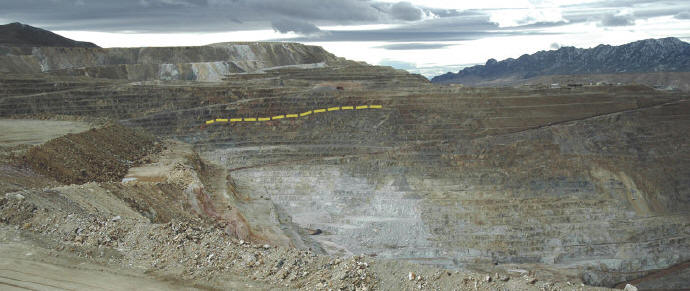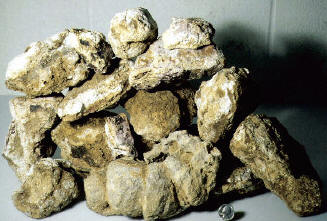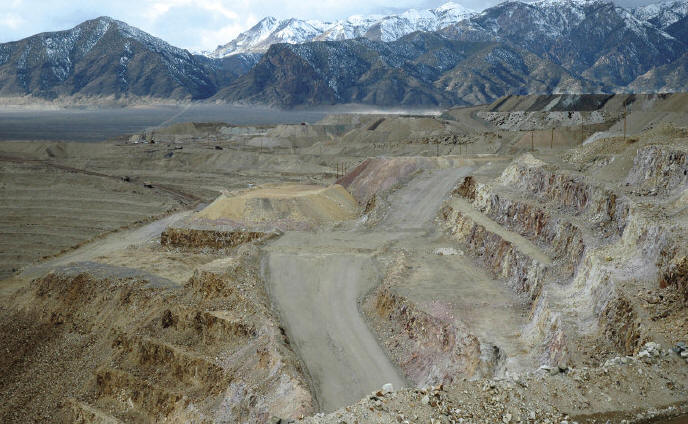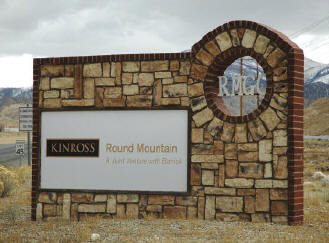Author: R. ScottWERSCHKY Date: 2014-9-24 18:41:46

Crystalized gold from Round Mountainmine. Size 6.8 cm. Spirifer collection.
Imagine going to the Tucson Gemand Mineral show, and seeing some newgolds from a mine you have never heardof. They are leafy specimens with bright,shiny, yellow gold and hints of octahedralcrystals on the edges. The specimens arepretty and inexpensive, and you have tohave one. Then you return to Tucson thenext year and see more golds from thesame mine with even better crystals.
Now do this for several years in a row,finding different crystal habits, biggerand better crystals, better luster, andlarger specimens both on and off matrix! Is it a collectors dream, or nightmare?
It is easy to justify having one good specimenfrom the mine, but does one reallyneed ten pieces just because they areall different? This dilemma has manymineral collectors, and especially goldcollectors, scratching their heads andthen digging deep into the pocket booksall because the Round Mountain minewent from being an obscure gold localityto being a world class specimen producervirtually overnight.
HISTORY
Nevada is known as the Silver State,stemming from the famous silver minesof the Comstock Lode discovered in 1859.
Prospectors bound for the California Mother Lode found placer gold nearwhat is now Dayton, Nevada. Althoughlooking for gold, they struck it rich withsilver at Virginia City just a few kilometersnorth of Dayton. This success withsilver dictated the exploration focus in Nevada for the next 40 years. The subsequentdecline of the mines of the Comstocklead to renewed exploration effortswhich resulted in several major goldrushes in Nevada starting around 1900.

Map of North America with location of Round Mountain and aerial view of the open pitmine.
Many famous gold mines were found atthis time, including Round Mountainwhich was discovered by Louis Gordonin 1906. In a very short time, there werethousands of miners living in tents andprimitive wooden shacks. At the peak,Round Mountain was producing a lot ofgold each year, especially consideringthe labor intensive mining methods ofthe era. The district produced more than300 kg (10,000 troy ounces) of gold ayear during early years. The heyday ofmining lasted through the 1930’s, and shut down completely with the onset ofWWII. Round Mountain remained moreor less dormant until the late 1960’swhen the Ordich Group picked up theclaims. The present day Round Mountainmine was commissioned in 1977 with initialinferred (not proven) gold reservesof 18.6 metric tones, and a planned minelife of about 6 years. Through a series ofmergers and buyouts, the mine is nowa 50:50 joint venture between BarrickGold and Kinross with Kinross acting asoperator. The mine has been in continualoperation since 1977, with peak goldproduction of over 22.7 metric tonnes(730,000 ounces) per year. Total productionto date is nearly 373.2 tonnes (12million ounces) plus the approximately10.9 tonnes (350,000 ounces) minedbefore 1977. Current gold reserves arereported at 46.6 metric tonnes at a gradeof 0.64 g/t, with an expected mine life ofabout 3 years. These figures are basedon current gold prices, and futurechanges may extend the mine life especiallyif they elect to pursue undergroundmining. At a minimum, total gold productionfor the district will be a staggering435.4 tonnes (14 million ounces) bythe time it is mined out! Not bad for amine that started out with hopes of producingless than 20 tonnes of gold!

Crystalized gold. Size 8 cm. A. Day coll. J. Scovil photo.

Round Mountain pit with approximate location of original high grade vein. S. Werschky photo.
The first gold specimens foundduring modern mining operations were encountered around 1980 in the denselywelded tuffs at the top of the calderacomplex. While exciting to geologists,these unimpressive specimens were typified by very fine grained disseminationand/or supergene enrichmentswithin silicified tuffs. There are probablyonly a few of these specimens in existence,likely well hidden by dust on somegeologist’s desk.

36 kg pile of gold from the high grade vein! Photo taken ca. 1992 by B. Veek.
Until the early 1990’s, Round Mountainwas considered to be a very lowgrade deposit that was remarkable onlyin the total lack of visibly interestingrock textures or veining.
Things foreverchanged in March of 1992, when coarsegold was found in a blast hole. A routineore control assay of blast hole cuttingscame in at greater than 30 g/t, quite adivergence from the expected 0.6 g/t.

Western portion of the Round Mountain pit with heap leach pads in middle distance,and Toiyabe Range in far distance. S. Werschky photo
Assuming there to be some sort of analyticalerror, geologists sampled drill cuttingspiled up around the drill hole.
Processing the cuttings with a goldpan yielded more than one kilogram ofcoarse grained gold from what turnedout to be the discovery of the first modernday high-grade vein.
Since thisdiscovery, approximately 150 high grade veins have been encountered. Projectionof the high grade vein trend up to thepre-mining surface on Stebbins Hill correlateswith veins worked during earlymining around 1910. Historical researchshowed that coarse gold was indeedknown back then as evidenced by photosof large gold specimens displayed duringa gold mining conference in Chicago, Illinoiscirca 1909.
It is estimated that more than 9330kg (300,000 ounces) of coarse gold havebeen recovered since 1992. Unfortunately,no records exist for historic productionof specimen-grade gold.
After the discovery of the high gradevein in 1992, geologists at the mine convincedmanagement to initiate a salesprogram in which all employees couldbuy a few pieces of gold at the prevailingworld gold market price. The sale wasdone in December as an informal Christmaspresent to the miners. The goldsales to employees continued through2006, after which management decidedto terminate the program. In addition tosales to the employees, the mine has hadtwo sales to mineral/gold dealers, one in1992, and the last in 2006. The vast majorityof specimens one sees on the markethave come from individual minerswho have sold their golds to mineraldealers.
LOCATION
The Round Mountain mine islocated on the western flank of the Toquima Range in central Nevada,approximately 240 km east-southeast ofCarson City. It is in the heart of the Basinand Range Physiographic Province.

Sign at the entrance to the Round Mountain mine. S. Werschky photo.
For those familiar with the vast desertsand mountains of the Western UnitedStates, it might appear to be in “the middleof nowhere”. For those lovers of crystallinegold, it is arguably “the centerof the Universe” (at least temporarily).
The original town site of Round Mountain still exists, and is adjacent to thepresent day open pit mine. Perhaps 40people still live there, although the miningcompany is trying to convince themto relocate in order to expand the openpit mine to the northeast which wouldconsume the town. Most of the minerslive in the small town of Carvers or thecompany sponsored housing in what isknown as the Hadley Subdivision.

A rare specimen with gold included in,and on, a euhedral quartz crystal. Size 4.6cm. Miner’s Lunchbox coll. J. Scovil photo.










 YueGongAnBei 44051102000467
YueGongAnBei 44051102000467


 |
|